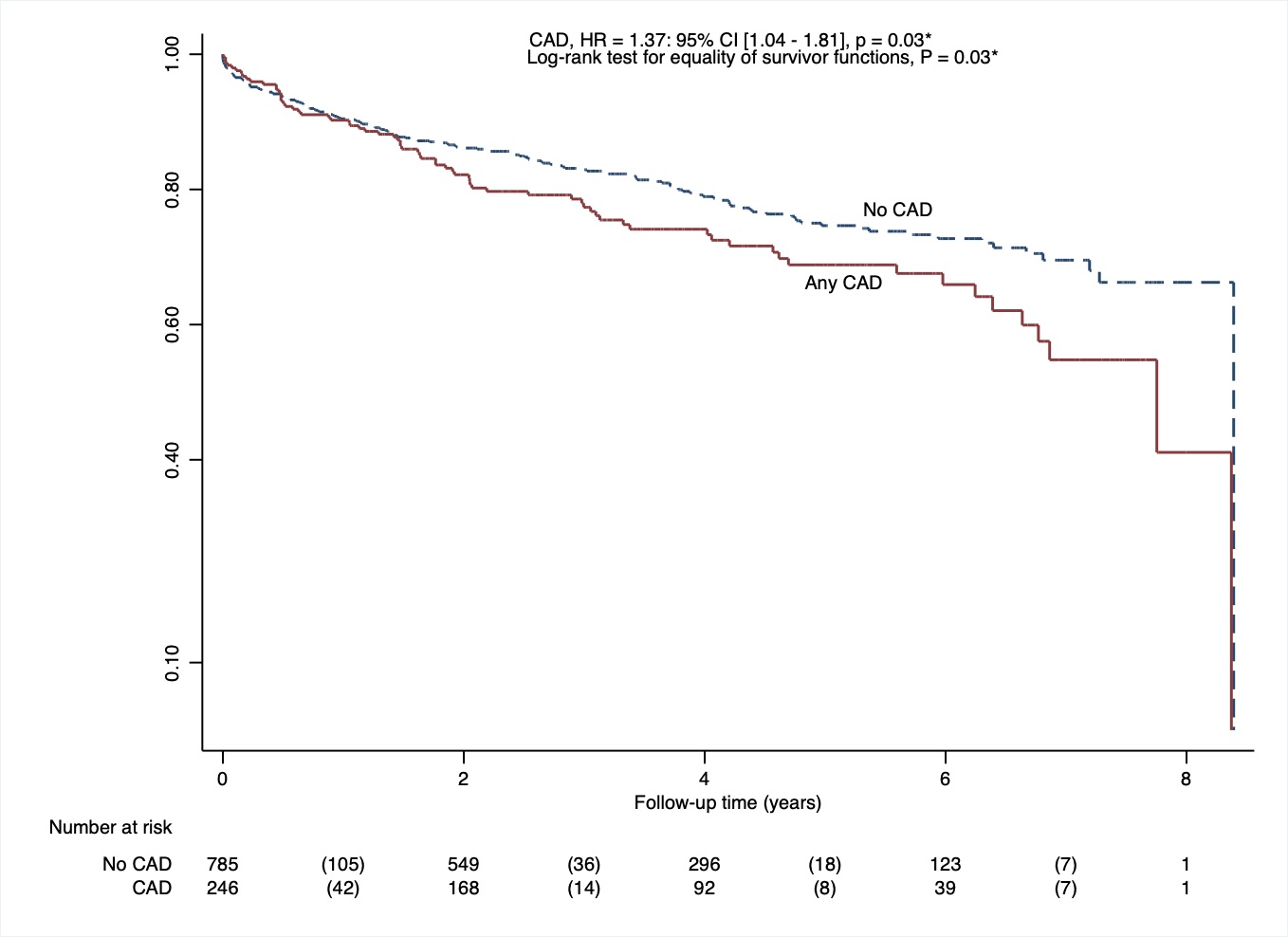History of Coronary Artery Disease Predicts Inferior Survival in Liver Transplant Recipients of Advanced Age in a Large Multicenter U.S. Cohort
1U of Wisconsin, Madison, WI, 2Stanford, Palo Alto, CA, 3U of Massachusetts, Worcester, MA, 4U of California, San Francisco, CA, 5Northwestern, Chicago, IL, 6U of Pennsylvania, Philadelphia, PA, 7Columbia, New York, NY, 8Florida Hospital, Orlando, FL, 9U of Arizona, Phoenix, AZ, 10Duke, Durham, NC, 11U of Chicago, Chicago, IL, 12Henry Ford Hospital, Detroit, MI, 13Scripps, San Diego, CA
Meeting: 2020 American Transplant Congress
Abstract number: 482
Keywords: Age factors, Liver transplantation, Multicenter studies, Outcome
Session Information
Session Name: Liver: Recipient Selection
Session Type: Oral Abstract Session
Date: Saturday, May 30, 2020
Session Time: 3:15pm-4:45pm
 Presentation Time: 4:15pm-4:27pm
Presentation Time: 4:15pm-4:27pm
Location: Virtual
*Purpose: Coronary artery disease (CAD) is common in patients of advanced age and does not preclude liver transplantation (LT) if adequately treated. We aimed to characterize the effect of CAD on patient and graft survival in LT recipients (LTRs) >65 years (y) of age.
*Methods: All primary LTRs > 65y from 2010-16 at 13 centers were included in the Re-Evaluating Age Limits in Liver Transplantation (REALT) consortium. The presence of pre-LT CAD was defined as revascularization, left heart catheterization with any CAD, or prior coronary artery bypass grafting. Post-LT patient and graft survival was assessed using cox-proportional hazard models, log rank tests and Kaplan Meier curves.
*Results: Of 1031 LTRs, 246 (24%) had pre-LT CAD with a median age of 68. The median MELDNa at LT was 20 (IQR 14-28) and median allocation MELD was 26 (IQR 20-23). LTRs with CAD were more likely to be male (73% vs 61%, p=0.001) and have non-alcoholic fatty liver disease (29% vs 17%, p<0.001). LT centers performing >100 LT per year were more likely to transplant subjects with pre-LT CAD (p<0.001). In univariate analysis, 1y (HR=1.02, 95%CI [0.64-1.61], p=0.94) and 3y (HR=1.52, 95%CI [0.89 - 2.59], p=0.13) patient survival were similar but 5y (HR=2.54, 95%CI [1.03 -6.31], p=0.04) and overall survival lower (HR=1.37, 95%CI [1.03 - 1.81], p=0.03). Subjects >70y were also at a higher risk for mortality (HR=1.35, 95%CI [1.01-1.81], p=0.04) when compared to subjects 65 – 69y. After adjusting for significant univariate factors, pre-LT CAD still predicted worse patient survival (HR = 1.39, 95% CI [1.03-1.87], p=0.03).
*Conclusions: Among LTRs >65y, pre-LT CAD was significantly associated with a lower 5y and overall patient survival post-LT. Interestingly, a history of CAD did not affect 1 and 3y patient and graft survival in patients of advanced age.
To cite this abstract in AMA style:
German M, Hristov A, Lee A, Osman F, Kwong A, Devuni D, Wang C, Boike J, Jo J, VanWagner L, Serper M, Sharma R, Verna E, Shor J, Koteish A, Sehmbey G, Seetharam A, John N, Patel Y, Kappus M, Couri T, Paul S, Salgia R, Nhu Q, Frenette C, Lai J, Goel A, Spengler E. History of Coronary Artery Disease Predicts Inferior Survival in Liver Transplant Recipients of Advanced Age in a Large Multicenter U.S. Cohort [abstract]. Am J Transplant. 2020; 20 (suppl 3). https://atcmeetingabstracts.com/abstract/history-of-coronary-artery-disease-predicts-inferior-survival-in-liver-transplant-recipients-of-advanced-age-in-a-large-multicenter-u-s-cohort/. Accessed December 12, 2025.« Back to 2020 American Transplant Congress

